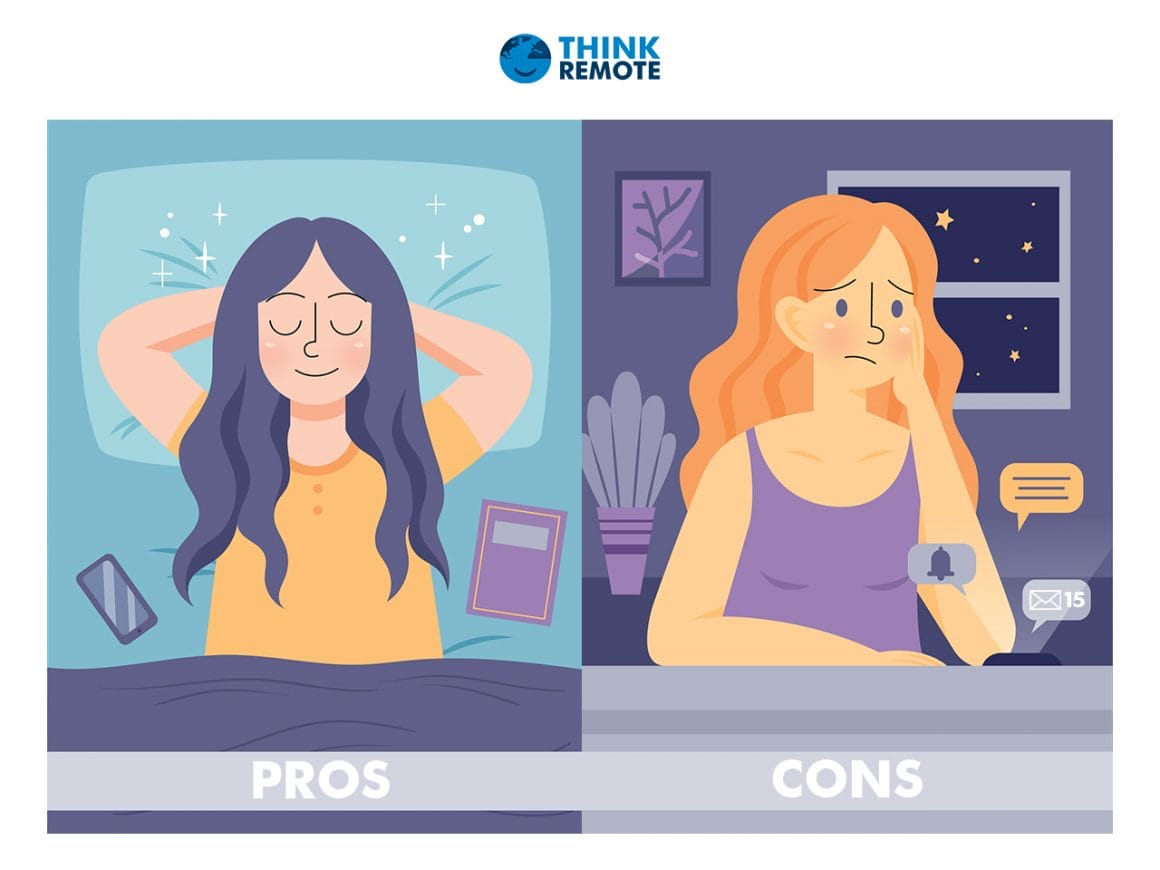Working from home is considered to be such the “Holy Grail”. It has a lot of benefits, but we can ignore that it also has not-so-good parts. In this post, we go deeper into remote work pros and cons, so you can decide if this fits your needs and personality… or you better go to the office.
Let’s imagine… it’s a Monday morning, and you don’t have to catch the bus or brave rush hour traffic to get to the office. Instead, you’re sitting comfortably in your pajamas, sipping on a fresh cup of coffee, and logging into your work computer from the comfort of your own home.
Working remotely has become increasingly popular in recent years, and it’s easy to see why. A survey found that 69% of respondents like working from home, and 82% want to work at least once a week from home.
With the freedom to balance work and personal life, remote work offers flexibility like never before. But is it all sunshine and rainbows? The truth is, while remote work can be liberating, it also comes with its own set of challenges.
What Are the Pros and Cons of Working From Home?
TL:DR
| Pros | Cons |
| Flexible schedule | Fear of missing out |
| Increased productivity and performance | Information overload |
| Positive environmental impact | Struggles to find motivation |
| Work from anywhere | Loneliness |
| Save more money | Work/life balance |
| Healthier lifestyle | Increased home cost |
6 Reasons Why You Should Work From Home
Remote working has a wide range of benefits to the employer, employee, and the planet. Here are just a few of them:
1. Flexible Schedule
One of the benefits of working from home is that you may be able to work under a flexible schedule. Your routine and time management can be tailored to your liking as long as you keep up with your daily tasks, so you don’t need to be at your desk 9-5.
This depends on the role and your employer, of course, but even if you have core working hours, you will usually have more autonomy on what you do and when.
A flexible schedule has many benefits. If you’re not a morning person, you could start later and work in the evening or take breaks during the school run.
Even if you don’t have full flexibility, you can have a little more control in spending your time, like walking your dog in a break, hanging out the laundry, or going to lunch with a friend.
2. Increased Productivity and Performance
Fewer distractions, fewer office politics, a quieter noise level, and replacing the office with your favorite home spot are factors that lead to higher productivity and efficiency at work, which benefits both employers and employees.
But productivity isn’t the only proof of success in remote workers. When done right, remote work allows companies to focus on performance.
This concept includes team members’ engagement, commitment, learning, growth, innovation, and contributions to the community as a whole, turning productivity into one factor of the overall performance.
3. Positive Environmental Impact
With the average American spending 55 minutes a day on their commute, it’s easy to see how working from home can have a huge impact on the environment.
Not making those journeys significantly reduces the emissions produced from your working day. If just one in four Americans worked remotely (approximately 39 million people), that would be the equivalent of taking 6,000,000 cars off the road for an entire year. It doesn’t end there though.
With more communication being done electronically, that reduces paper waste significantly. Video calls have become the new way to have meetings that previously involved being in the office or going to client sites, reducing emissions even further.
4. Work From Anywhere
Unless it specifically states so in your contract, you are not tied to your home either. If your home office isn’t cutting it for you, then a quick trip to a library, coffee shop, or coworking space might help get you out of a rut.
Then there’s the digital nomad lifestyle, where you can travel the world, working to fund your lifestyle. This can allow you to log in from different towns, countries, or even continents.
5. Save Your Money
Transportation, car maintenance, monthly parking fees, a professional wardrobe, your morning coffee, or bought-out lunches, all of these expenses are gone when working from home.
This can translate to a significant cost reduction and annual savings. Your bank account will notice the difference. You’ll save all the costs of commuting and all the other expenses you make when going to the office.
💡 You may want to read: Jobs for Stay-At-Home-Moms
6. Healthier Lifestyle
Working from home has also been shown to lower stress levels, provide more time for hobbies and interests, and improve personal relationships, especially with our relatives. The lack of a commute alone brings significant health benefits, lowering blood pressure and reducing headaches and back pain.
It also makes it easier for you to fit exercise into your daily routine. That 55 minutes you save on the morning commute can be used to go for a run or hit the gym.
You can spend your lunch break on an exercise bike and not worry about showering until later as you have no colleagues to consider.
6 Disadvantages of Remote Work
Of course, nothing is all sunshine and roses, and working from home does have its downsides too. It’s definitely worth keeping these in mind when you’re considering a remote option so you can give yourself the best chance of success.
1. Fear of Missing Out
Unless the company you work for has got communication just right, there is a risk that you might experience FOMO (the fear of missing out) while you work from home.
This is partly on the social side as it’s more difficult to cultivate good working relationships with your team if you’re from home. But there is also anxiety amongst remote workers that they are ‘out of sight, out of mind’ when it comes to recognition and promotion.
When you’re interviewing for a remote role, it’s worth asking your potential manager how that is managed. Does the company hold regular get-togethers in real life or online social events? What will the onboarding process look like?
2. Communication Overload
Communication between remote workers requires several channels: phone, email, video calls, text, direct messages, and more.
Every question, every answer, and every approval becomes a document on a remote team, even write-ups, making it great for records but high loads of information to sort through.
With all the instant messaging apps, video call software, project management tools, and God-blessed email, it’s no surprise employees are worried about information slipping from them.
If you find yourself getting overloaded, work with your manager to find a way to reduce unnecessary communications and meetings. Zoom fatigue has become a recognized phenomenon as a result of remote work, so try to schedule breaks in between meetings to help you recover.
3. Finding Motivation
When you’re working from an office, the commute gives you time to get into ‘work mode’, and banter with your colleagues keeps you motivated. It’s harder to achieve this when you’re working from home.
It can help to set up a work routine or ritual to help prepare your brain to move from downtime to work:
- Set up a dedicated workplace: you need a comfortable space to work without interruptions or distractions.
- Establish a routine: try to work at the same time every day; it’s a helpful signal to start your day and practice healthy boundaries.
- Be aware of the ergonomics: though the couch seems tempting, a chair that supports your back will be the best.
- Take breaks: get up, move around, take your pet for a walk, or have lunch with a friend, but avoid working for more than three hours at a time.
4. Loneliness
Although some employees enjoy working alone without distractions, some may find it difficult to spend long hours in front of a screen without face-to-face interaction.
You can combat that by getting out of the house every day, even if it’s only just for a walk around the block. Alternative workspaces include coffee shops, libraries, hotels, and co-working spaces.
You can also make use of the extra time you get from not having a commute by adding more social time into your life. Meet friends for coffee, head to the gym, or join a local club to help widen your in-person contact.
Note: if you want to go deeper into this topic, you can watch this video in which one of our colleagues goes in-depth on how remote work could affect workers’ need for social connection.
5. Work/Life Balance
While remote work is often touted as a way to improve your work-life balance, it can have a negative impact.
The problem comes if you don’t have good boundaries when work starts to creep outside of regular working hours and take up more of your life.
For example, you might start to sit down at your desk at 8 when you’d usually start at 9. Or maybe you just do another twenty minutes to get something finished or end up working on the weekend. You get the idea.
If you find yourself with more work than you can reasonably do on a regular basis, then it’s probably worth speaking to your line manager about expectations.
If you find yourself getting distracted during the day, then there are tools like the Cold Turkey app that can help you stay on target, and having set working hours can help stop work from taking over.
6. Increased Home Costs
If you work from home, you’ll need more energy to heat or cool your home, use lights, charge your laptop, phone, tablet, etc., and connect to the internet. Here are some tips to help minimize the costs.
- Turn the thermostat down: a couple of degrees can significantly lower carbon emissions and cut your monthly gas and electric bills.
- Embrace natural light: be careful when choosing your home office room; natural light is essential to feel healthier and happier.
- Avoid using the printer: you don’t need all those printed documents; you can store them in the Cloud!
- Unplug devices from the wall: it’s a massive waste of energy and can increase your electricity bills!
You may also need to buy new furniture, like a desk and an ergonomic chair.
According to Global Workplace Analytics, a typical company can save around $11,000 per year for every team member who works from home at least some days of the week. For this reason, some companies either provide furniture and equipment or pay a work-from-home stipend to help meet the financial costs.
5 Factors to Consider When Deciding to Work From Home
Now that you know the positives and negatives of working from home, here are a few things you must consider before taking the plunge:
1. Personal Preference
Working from home may not be for everyone. Some people thrive in a traditional office environment, while others prefer the flexibility and autonomy that comes with working from home.
Before deciding to work from home, consider your personal preferences and whether you have the discipline to work independently.
2. Type of Job – Level of Autonomy
Some jobs are better suited for remote work than others. If your job requires frequent face-to-face interaction with clients or colleagues, working from home may not be practical.
On the other hand, if your job involves a lot of independent work or online communication, working from home may be a good fit.
Also, consider the level of autonomy you have in your job. If you need a lot of guidance or supervision, working from home may not be the best option.
3. Family and Personal Responsibilities
Those with family responsibilities or personal commitments may find working from home more flexible. However, it can also create distractions if you have children or other family members at home during your work hours.
Think about whether you have the support and resources to balance your work and personal obligations before deciding to work from home.
4. Technology and Equipment Needs
Technology and equipment are needed to work remotely, including a computer, internet connection, and phone. When considering working from home, be sure you have the equipment and technology you need.
5. Availability of a Dedicated Workspace
A home office must be a distraction-free workspace where you can work without interruptions.
Take into account whether you have a quiet, comfortable space in which you can work uninterrupted at home. If you don’t have a dedicated workspace, you may need to create one before you start working from home.
Remote Work: It’s All About the Balance!
Like everything else, there are work-from-home pros and cons, but for many people, the benefits of spending time at home definitely outweigh the downsides! We hope that the strategies we’ve given here will help you make remote working work for you.
Frequently Asked Questions
– A lack of teamwork and community.
– Motivational issues.
– Continuous interruptions and unmonitored performance.
– Inadequate office equipment.
– Workplace distractions.
– Burnout.
– The risk of productivity loss.
– The schedule is more flexible, and your day-to-day life is easier to manage.
– You won’t have to spend time commuting.
– Work tasks and assignments can be completed faster.
– You spend less money.
– You can work from anywhere in the world.
According to research, yes. In a survey of 1,000 remote and hybrid employees in the U.S., researchers questioned them on their productivity, wellness, and other aspects of their lives. It was proven that working from home improved work-life balance, boosted productivity and led to healthier habits






